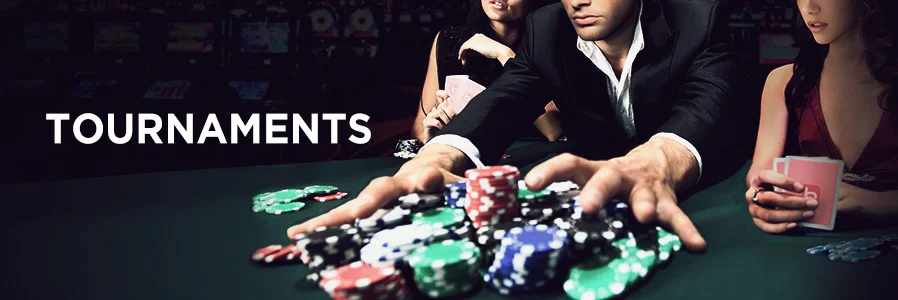Poker Tournaments

Poker Tournaments for Real Money in Canada
ONLINE Poker Tournaments For Real Money in Canada
Online poker tournaments offer players the opportunity to compete for substantial prize pools with relatively small investments. From quick Sit & Go events to major multi-table tournaments, poker tournaments provide a different dynamic compared to cash games, requiring unique strategies and bankroll management approaches.
best Online poker Tournaments for real money at Bodog
Poker tournaments come in various formats, each offering distinct challenges and opportunities. Whether you're a beginner looking to build experience or a seasoned player aiming for major prizes, understanding these formats is crucial for tournament success.
Texas Hold'em Tournaments
Texas Holdem events feature buy-ins from $1 to $1,055, with daily guaranteed tournaments running around the clock. Online Poker Tournaments formats span from regular Freezeout events, Monster Stacks, Knockout events with fixed bounties, progressive knockouts where bounty values increase with each elimination, to mystery knockout tournaments offer random bounties worth up to tens of times the buy-in amount.
Sunday majors represent the peak of weekly tournament action, with five premier events offering combined guarantees exceeding $500,000. The schedule begins at 13:33 ET with the Triple-Header Warm-Up with an accessible $11 buy-in tournament guaranteeing $10,000, followed by the $75,000 guaranteed Triple-Header Kickoff Event at 14:33 ET ($109 buy-in). The centerpiece Triple-Header Main Event at 15:33 ET guarantees $150,000 for a $1,055 buy-in, while the $200,000 guaranteed event at 16:00 ET provides tremendous value at $162. The schedule concludes with an $100,000 guaranteed High Roller at 18:00 ET, priced at $325 for serious competitors.
Omaha Tournaments
Pot Limit Omaha tournaments combine the complexity of four-card holdings with dynamic prize pool structures, offering both freezeout and re-entry formats. The Omaha tournament schedule expands during promotional periods with special events like Deep Stack tournaments, Progressive Knockouts with escalating bounties or Turbo events.
Multi-table online poker tournaments accommodate up to 2,000 players in regular events, with fields expanding to 5,000 during major series. Buy-ins generally range from $1 to $100, creating substantial prize pools that frequently exceed guarantees. Tournament formats include speed variations from regular blind structures to hyper-turbos, while knockout events add bounty prizes ranging from 30% to 50% of the buy-in. Satellite tournaments run daily, offering qualification paths to larger events for as little as one-tenth of the direct entry cost.
Omaha Hi-Lo Tournaments
Split-pot tournaments feature three distinct betting structures (Fixed Limit, Pot Limit, No Limit), accommodating different playing styles and skill levels. Tournament variations span from regular freezeout events to re-entry formats, while knockout tournaments combine high-low split pots with bounty rewards worth 30% to 50% of the buy-in.
Buy-ins range from $1 to $100. Regular tournaments generally feature 10-12 minutes blind levels, while turbo events accelerate the action with below 6-minute levels. The Monster Stack format, popular in the $55-$109 buy-in range, provides 15,000 starting chips for extended play and deeper strategy opportunities.
Different Formats
Sit & Go tournaments initiate play when the designated number of players register, typically taking 20-45 minutes for completion depending on the number and size of tables. These events run around the clock, with 6-max tables being the most popular format, followed by 9-handed and heads-up variations. Buy-ins range from $1 to $100.
Multi-table tournaments represent the largest portion of poker tournaments online, with guaranteed prize pools ranging from $200 to $200,000. Slow events feature 15-minute blind levels Regular events feature 10-minute blind levels, while turbo formats accelerate to 6-minute levels. Deep stack tournaments provide 15,000+ starting chips, creating an average duration of 4-10 hours until completion.
Structures
Poker tournament speeds vary significantly, affecting strategy and time commitment. Regular structures feature 10-minute blind levels, turbos reduce to 6 minutes, and hyper-turbos accelerate to 3-minute levels. Deep stack events begin with 200+ big blinds, while regular tournaments start at 100 big blinds. Progressive knockout tournaments typically allocate 50% of the buy-in to bounties, with values increasing by 25% after each elimination.
Why Play ONLINE Poker Tournaments at Bodog
Tournament diversity stands out with over 100 daily events across all variants. Guaranteed prize pools exceed $2.5 million weekly, with Sunday tournaments accounting for $500,000 of that amount. Player-friendly features include 40-120-minute late registration periods and re-entries in selected events.
The satellite system provides significant value, with qualifiers starting at one-tenth of the target tournament's buy-in. Special promotional series run all year long, featuring enhanced guarantees and additional tournament formats.
The combination of reliable software, consistent tournament schedules, and substantial guarantees creates a compelling environment for both recreational players and serious competitors. With buy-ins accommodating all bankroll levels and tournament types spanning every major poker variant, players can find their preferred format while competing for meaningful prizes.



